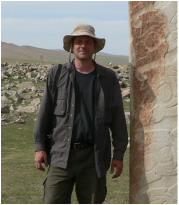Dr. Jean-Luc Houle
Department of Folk Studies
and Anthropology Western Kentucky University |
Jean-Luc is the project’s senior co-director. He is an anthropological archaeologist whose research interests focus on the social and ritual construction of landscapes and the sense of territoriality among mobile pastoralists, as well as on human-environment relationships and how all this relates to the development of complex societies in Inner Asia. Particularly, his interests and methodological foci include: the origins and development of complex societies, landscape archaeology, regional settlement pattern studies, household archaeology, quantitative and spatial analysis, nomadic pastoralist socio-political organization, ethnoarchaeology, and ritual practices.
|
Dr. Jamsranjav BayarsaikhanNational Museum of Mongolia
|
Bayaraa (as we call him) is the project’s co-director. He is the head of the research center at the National Museum of Mongolia. He is also the chief Mongolian archaeologist for several international projects in Mongolia and the Executive Director of the Mongolian Tangible Heritage Association, NGO, which received a United States Ambassador’s Grant for a project to preserve a large deer stone site in Khanuy Valley (central Mongolia). His research focuses on Bronze Age stone steles, ritual monuments and evidence of shamanistic traditions.
|
DR. Oula SeitsonenArchaeologist and
geographer University of Helsinki, Finland |
Oula is the project’s lithics and GIS specialist and oversees our entire site recording. He is an archaeologist and geographer who works as a researcher in the project "Lapland's Dark Heritage" at the University of Helsinki, Finland. His specialties range from 20th century conflict archaeology, Geographical Information Systems, and digital documentation methods, to Stone Age lithic studies. He has done archaeological research in many world regions, including East Africa (Kenya and Tanzania), Finland, Lapland, NW Russia, Siberia, Alaska and Mongolia.
|
|
After graduating in Physical Geography from Barcelona University, Natalia started her MSc in Archaeology and completed her training as soil micromorphologist. She is currently working on her PhD project in Kiel University (Germany), focused in understanding the micro-taphonomy of stabling floors, dung layers and coprolites in soils of mobile communities in Mongolia using soil Micromorphology coupled with Compound Specific Stable Isotopes analysis. Her research aim is to use these biomarkers for obtaining information about the long-term dynamics of pastoral habitat adaptations and multi-resource economic strategies, crucial to understand living conditions, mobility, seasonality and diet of both humans and animals in Pre and Protohistory. She has also worked as a Geoarchaeologist in several Middle Palaeolithic, Upper Palaeolithic and Neolithic sites.
|
|
Lee is the project's zooarchaeologist. He gained his undergraduate degree in Archaeology in 2007 (Exon), before obtaining an MSc in Environmental Archaeology and Palaeoeconomy (Sheffield) and an MA in Cornish Studies (Exon). He is a zooarchaeologist at Oxford Archaeology and works as a freelance zooarchaeologist and ethnoarchaeologist at zooarchaeology.co.uk, as well as studying for a PhD at the University of York. His PhD research focuses on the vertebrate taphonomy of urban environments. He is a fellow of the Zoological Society of London and a member of several other academic and professional organizations. Lee's research interests center around paleoecology, palaeoeconomy and pastoralism, themes which feature in current research projects in sub-Saharan Africa as well as this project.
|




